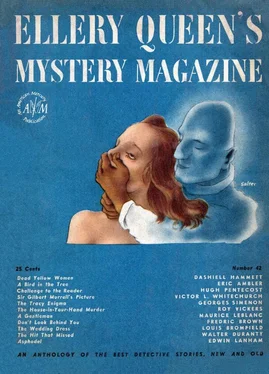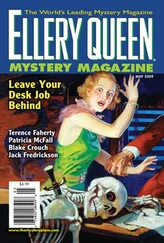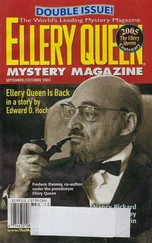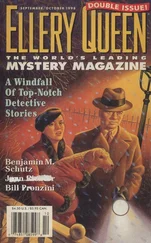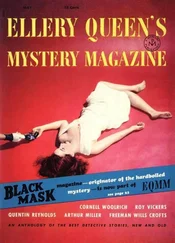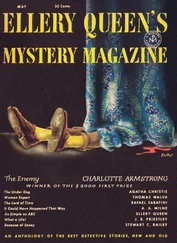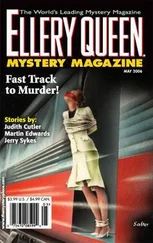Эрик Эмблер - Ellery Queen’s Mystery Magazine. Vol. 9, No. 42, May 1947
Здесь есть возможность читать онлайн «Эрик Эмблер - Ellery Queen’s Mystery Magazine. Vol. 9, No. 42, May 1947» весь текст электронной книги совершенно бесплатно (целиком полную версию без сокращений). В некоторых случаях можно слушать аудио, скачать через торрент в формате fb2 и присутствует краткое содержание. Город: New York, Год выпуска: 1947, Издательство: The American Mercury, Жанр: Классический детектив, Детектив, на английском языке. Описание произведения, (предисловие) а так же отзывы посетителей доступны на портале библиотеки ЛибКат.
- Название:Ellery Queen’s Mystery Magazine. Vol. 9, No. 42, May 1947
- Автор:
- Издательство:The American Mercury
- Жанр:
- Год:1947
- Город:New York
- ISBN:нет данных
- Рейтинг книги:3 / 5. Голосов: 1
-
Избранное:Добавить в избранное
- Отзывы:
-
Ваша оценка:
- 60
- 1
- 2
- 3
- 4
- 5
Ellery Queen’s Mystery Magazine. Vol. 9, No. 42, May 1947: краткое содержание, описание и аннотация
Предлагаем к чтению аннотацию, описание, краткое содержание или предисловие (зависит от того, что написал сам автор книги «Ellery Queen’s Mystery Magazine. Vol. 9, No. 42, May 1947»). Если вы не нашли необходимую информацию о книге — напишите в комментариях, мы постараемся отыскать её.
Ellery Queen’s Mystery Magazine. Vol. 9, No. 42, May 1947 — читать онлайн бесплатно полную книгу (весь текст) целиком
Ниже представлен текст книги, разбитый по страницам. Система сохранения места последней прочитанной страницы, позволяет с удобством читать онлайн бесплатно книгу «Ellery Queen’s Mystery Magazine. Vol. 9, No. 42, May 1947», без необходимости каждый раз заново искать на чём Вы остановились. Поставьте закладку, и сможете в любой момент перейти на страницу, на которой закончили чтение.
Интервал:
Закладка:
“I’ll have that opened, please, Mrs. Ledlaw!”
“Oh, very well, if you wish!” Mrs. Ledlaw did not know why her husband had shouted that nonsense about removing the certificate. It surely couldn’t matter much when they re-married.
Inside the case were: a packet of Mrs. Ledlaw’s letters, a photograph album, a rare edition of Canterbury Tales, the marriage certificate, a few other oddments and — Henshawk’s drawing of the cottage, loosely wrapped in tissue paper.
About the Story: The first Department of Dead Ends story was Roy Vickers’s “The Rubber Trumpet.” The moment we finished that tale of The Merry Widower we realized that we had just completed a rare experience — we had read a contemporary classic in the field of the detective short story. Immediately we set about purchasing the story for EQMM, and with it all the other Department of Dead Ends stories written up to that time — a half-dozen or so; further, we urged the author’s American literary agent to persuade Mr. Vickers to continue the series by writing originals especially for EQMM — we were that certain from the very beginning that readers of EQMM would find the Department of Dead Ends one of the most fascinating criminological bureaus in all the annals of detection and the stories themselves one of the most satisfying crime series in modem fiction.
We were not wrong: constant readers of EQMM have testified to that. Like present-day Oliver Twists they keep asking for more.
A short time after we published “The Rubber Trumpet” we received professional confirmation of our critical opinion. One day we traveled to Morningside Heights with Herbert Mayes, the remarkably perceptive editor of “Good Housekeeping,” to serve as one of his panel of “guest experts” in the post-graduate course in Journalism at Columbia University. Sitting next to us on the platform was Carl Van Doren, the famous author, critic, biographer, and Pulitzer Prize winner. At the end of the class the “lecturers” tarried long enough to talk shop. Imagine our delight when Mr. Van Doren complimented us on having published “The Rubber Trumpet”! He was so impressed by the story that he considered it one of the finest detective shorts he had ever read. Mr. Mayes was piqued by Mr. Van Doren’s enthusiasm and asked to be let in on a good thing. The very next day we sent a copy of EQMM containing “The Rubber Trumpet” to Mr. Mayes by special messenger and subsequently Mr. Mayes added his editorial accolade. Indeed, in the three and a half years since “The Rubber Trumpet” originally appeared in EQMM, we have heard nothing but extravagant praise for that first tale of the Department of Dead Ends. Such connoisseurs as Christopher Morley, Vincent Starrett, Anthony Boucher, Howard Haycraft, James Sandoe, Charles Honce, E. A. Osborne, and other true aficionados, have written or spoken to your Editor, unanimously selecting that great story for the Honor Roll Award.
Well, the Department of Dead Ends series has grown mightily since the publication of “The Rubber Trumpet.” No less than a dozen D.D.E. stories have appeared in EQMM up to the time of this writing. Naturally, the level of quality has varied from story to story — no writer can produce a masterpiece every time he sits in front of his typewriter. Some of the later tales — like “The Man Who Murdered in Public” and “ The Case of the Merry Andrew ” — are four-star accomplishments; but while it can be said in absolute truth that Mr. Vickers has never written an indifferent Department of Dead Ends tale, no story that followed “The Rubber Trumpet” ever quite equaled that first major triumph.
Then, for EQMM’s Second Annual Contest, Mr. Vickers submitted another D.D.E. story — “The House-in-Your-Hand Murder.” Perhaps this new story also falls short of “The Rubber Trumpet”; but if it does, it falls short by the narrowest of margins. In your Editor’s opinion “The House-in-Your-Hand Murder” is the closest Mr. Vickers has yet come to performing a literary miracle — making lethal lightning strike twice in the same place. Like all the other stories in the series, “The House-in-Your-Hand Murder ” projects a kind of realism unmatched in its field. That realism, however, is not drab or prosaic. It is shot through with the credible fantasy which occurs repeatedly in real life — that peculiar touch of the unreal which somehow stamps all works of genuine imagination with the very trademark °f reality. You know what we mean — you’ve read the story...
Asphodel
by Edwin Lanham
The author of “Asphodel” the curiously disturbing tale we now present, was born in Texas on October 11, 1904. He graduated from Williams College, then studied art in New York and Paris. In 1930 he became a newspaperman, and still belongs to that wondrous tribe of legend-making scribblers. His best-known serious novel is THUNDER IN THE EARTH, which he wrote on a Guggenheim scholarship. In past years Edwin Lanham has been a steady contributor to “Collier’s” — in 1946 his serial, IT SHOULDN’T HAPPEN TO A DOG, was filmed by Twentieth Century-Fox under the same title and emerged from the Hollywood assembly line as an extremely amusing picture starring Carole Landis and Allyn Joslyn.
Also last year Mr. Lanham published his first detective novel — SLUG IT SLAY. Howard Haycraft ranked it as one of the best mystery books of the year, and nearly every other critic agreed. It is interesting to note that Mr. Lanham wisely uses his own experience as the background of his stories. SLUG IT SLAY (provocative title!) is a newspaper story, authentically peopled with real newspapermen and newspaperwomen. And in “Asphodel ” Mr. Lanham draws on his intimate knowledge of art (in this instance, sculpturing) to produce, in our opinion, one of the ten finest crime stories published during 1944.
Perhaps we should warn you: “Asphodel ” — where souls unbodied dwell — will positively haunt you...
From Collier’s magazine, copyright 1944, by Edwin Lanham
Edward Peters sat rigid in his chair, with his arms folded across his chest, his head bent slightly, and his eyes fixed on the point of high light on the bronze figurine of a faun. By looking at the faun he could hold the pose, and also he could avoid his wife’s eyes.
Usually it was Elaine who avoided meeting his eyes. She had a habit of turning her head away, ever so slightly, so that her vision was out of line with his, so that her face was almost profile, and until recently he had thought it a trick of coquetry.
But as she worked, her eyes moved boldly because she was not looking at him at all. Her sure hands pressed the clay with precision and her eyes studied him with the curious, impersonal concentration of the artist. It was not this impersonal quality that disturbed him, but a strange intensity that was new, that had not been apparent in the first six months of marriage. He sighed, moving one leg nervously.
Instantly she asked, “Tired, darling?”
“Head still aches.” He realized that he had said it plaintively.
“One more sitting and I’ll be finished,” Elaine said. Her tone was formal, as if he were one of those who paid a thousand dollars for a bust by Elaine Peters. But their conversations had always been either formal or evasive, markedly so in the past few days, since he had found the letter in her handbag.
If he had been able to break through this impersonal barrier, this defense in depth she had developed, they might have talked about the letter and reached an understanding, but now it was impossible.
Читать дальшеИнтервал:
Закладка:
Похожие книги на «Ellery Queen’s Mystery Magazine. Vol. 9, No. 42, May 1947»
Представляем Вашему вниманию похожие книги на «Ellery Queen’s Mystery Magazine. Vol. 9, No. 42, May 1947» списком для выбора. Мы отобрали схожую по названию и смыслу литературу в надежде предоставить читателям больше вариантов отыскать новые, интересные, ещё непрочитанные произведения.
Обсуждение, отзывы о книге «Ellery Queen’s Mystery Magazine. Vol. 9, No. 42, May 1947» и просто собственные мнения читателей. Оставьте ваши комментарии, напишите, что Вы думаете о произведении, его смысле или главных героях. Укажите что конкретно понравилось, а что нет, и почему Вы так считаете.
